Improving Geographically Weighted Regression Considering Directional Nonstationary for Ground-Level PM2.5 Estimation
Abstract
1. Introduction
2. Materials and Methods
2.1. Study Area
2.2. Materials
2.2.1. Ground-Level PM2.5 Observations
2.2.2. AOD Data
2.2.3. Wind Data
2.2.4. Auxiliary Data
2.2.5. Data Integration
2.3. Methods
2.3.1. Geographically Weighted Regression Model (GWR)
2.3.2. Directionally Weighted Regression Model (DWR)
2.3.3. Extending the GWR Model Considering the Wind Influence (GDWR)
2.3.4. Parameter Estimation
2.3.5. Result Evaluation
3. Results and Discussion
3.1. Model Definition
3.2. Accuracy of the Models
3.3. Hypothesis Testing
3.4. Accuracy at Each Site
3.5. Results of Full PM2.5 Estimation with the GDWR Model
4. Conclusions
Author Contributions
Funding
Data Availability Statement
Acknowledgments
Conflicts of Interest
References
- ISO. Air quality–Particle size fraction definitions for health-related sampling. In ISO 7708; ISO: Geneva, Switzerland, 1995. [Google Scholar]
- Boldo, E.; Medina, S.; LeTertre, A.; Hurley, F.; Mücke, H.; Ballester, F.; Aguilera, I.; Eilstein, D.; Group, A. Apheis: Health impact assessment of long-term exposure to PM(2.5) in 23 European cities. Eur. J. Epidemiol. 2006, 21, 449–458. [Google Scholar] [CrossRef] [PubMed]
- Watterson, T.; Sorensen, J.; Martin, R.; Coulombe, R.A., Jr. Effects of PM2.5 Collected from Cache Valley Utah on Genes Associated with the Inflammatory Response in Human Lung Cells. J. Toxicol. Environ. Health 2007, 70, 1731–1744. [Google Scholar] [CrossRef]
- Evans, J.; van Donkelaar, A.; Martin, R.V.; Burnett, R.; Rainham, D.G.; Birkett, N.J.; Krewski, D. Estimates of global mortality attributable to particulate air pollution using satellite imagery. Environ. Res. 2013, 120, 33–42. [Google Scholar] [CrossRef]
- Liu, Y.; Koutrakis, P.; Kahn, R. Estimating fine particulate matter component concentrations and size distributions using satellite-retrieved fractional aerosol optical depth: Part 2-A case study. J. Air Waste Manag. Assoc. 2007, 57, 1360–1369. [Google Scholar] [CrossRef]
- Zhang, Y.; Cao, F. Fine particulate matter (PM2.5) in China at a city level. Sci. Rep. 2015, 5, 14884. [Google Scholar] [CrossRef]
- Hoff, R.M.; Christopher, S.A. Remote Sensing of Particulate Pollution from Space: Have We Reached the Promised Land? J. Air Waste Manag. Assoc. 2009, 59, 645–675. [Google Scholar] [CrossRef]
- van Donkelaar, A.; Martin, R.V.; Brauer, M.; Kahn, R.; Levy, R.; Verduzco, C.; Villeneuve, P.J. Global Estimates of Ambient Fine Particulate Matter Concentrations from Satellite-Based Aerosol Optical Depth: Development and Application. Environ. Health Perspect. 2010, 118, 847–855. [Google Scholar] [CrossRef] [PubMed]
- Kumar, N.; Chu, A.; Foster, A. An empirical relationship between PM2.5 and aerosol optical depth in Delhi Metropolitan. Atmos. Environ. 2007, 41, 4492–4503. [Google Scholar] [CrossRef]
- Kahn, R.; Banerjee, P.; McDonald, D. Sensitivity of multiangle imaging to natural mixtures of aerosols over ocean. J. Geophys. Res. Atmos. 2001, 106, 18219–18238. [Google Scholar] [CrossRef]
- Kahn, R.; Banerjee, P.; McDonald, D.; Diner, D.J. Sensitivity of multiangle imaging to aerosol optical depth and to pure-particle size distribution and composition over ocean: The Earth Observing System (EOS) AM-1 platform. J. Geophys. Res. 1998, 103, 32195–32213. [Google Scholar] [CrossRef]
- Liu, Y.; Park, R.J.; Jacob, D.J.; Li, Q.; Kilaru, V.; Sarnat, J.A. Mapping annual mean ground-level PM2.5 concentrations using Multiangle Imaging Spectroradiometer aerosol optical thickness over the contiguous United States. J. Geophys. Res. Atmos. 2004, 109, D22206. [Google Scholar]
- Yu, S.; Mathur, R.; Schere, K.; Kang, D.; Pleim, J.; Young, J.; Tong, D.; Pouliot, G.; McKeen, S.A.; Rao, S.T. Evaluation of real-time PM2.5 forecasts and process analysis for PM2.5 formation over the eastern United States using the Eta-CMAQ forecast model during the 2004 ICARTT study. J. Geophys. Res. Atmos. 2008, 113, D06204. [Google Scholar] [CrossRef]
- San Jose, R.; Pérez, J.L.; Morant, J.L.; González, R.M. Elevated PM10 and PM2.5 Concentrations in Europe: A Model Experiment with MM5-CMAQ and WRF-CHEM; WIT: Southampton, UK, 2008. [Google Scholar]
- Saide, P.E.; Carmichael, G.R.; Spak, S.; Gallardo, L. Forecasting urban PM10 and PM2.5 pollution episodes in very stable nocturnal conditions and complex terrain using WRF–Chem CO tracer model. Atmos. Environ. 2011, 45, 2769–2780. [Google Scholar] [CrossRef]
- Chu, D.A.; Kaufman, Y.J.; Zibordi, G.; Chern, J. Global monitoring of air pollution over land from the Earth Observing System-Terra Moderate Resolution Imaging Spectroradiometer (MODIS). J. Geophys. Res. Atmos. 2003, 108, 4661. [Google Scholar] [CrossRef]
- Engel-Cox, J.A.; Holloman, C.H.; Coutant, B.W.; Hoff, R.M. Qualitative and quantitative evaluation of MODIS satellite sensor data for regional and urban scale air quality. Atmos. Environ. 2004, 38, 2495–2509. [Google Scholar] [CrossRef]
- Li, C.; Hsu, N.C.; Tsay, S. A study on the potential applications of satellite data in air quality monitoring and forecasting. Atmos. Environ. 2011, 45, 3663–3675. [Google Scholar] [CrossRef]
- He, Q.; Huang, B. Satellite-based mapping of daily high-resolution ground PM2.5 in China via space-time regression modeling. Remote Sens. Environ. 2018, 206, 72–83. [Google Scholar] [CrossRef]
- Alexeeff, S.E.; Schwartz, J.; Kloog, I.; Chudnovsky, A.; Koutrakis, P.; Coull, B.A. Consequences of kriging and land use regression for PM2.5 predictions in epidemiologic analyses: Insights into spatial variability using high-resolution satellite data. J. Expo. Sci. Environ. Epidemiol. 2015, 25, 138–144. [Google Scholar] [CrossRef]
- Gupta, P.; Christopher, S.A. Particulate matter air quality assessment using integrated surface, satellite, and meteorological products: 2. A neural network approach. J. Geophys. Res. Atmos. 2009, 114. [Google Scholar] [CrossRef]
- Zhang, H.; Hoff, R.M.; Engel-Cox, J.A. The Relation between Moderate Resolution Imaging Spectroradiometer (MODIS) Aerosol Optical Depth and PM2.5 over the United States: A Geographical Comparison by U.S. Environmental Protection Agency Regions. J. Air Waste Manag. Assoc. 2009, 59, 1358–1369. [Google Scholar] [CrossRef]
- Brunsdon, C.; Fotheringham, S.; Charlton, M. Geographically weighted regression-modelling spatial non-stationarity. J. R. Stat. Soc. Ser. D Stat. 1998, 47, 431–443. [Google Scholar] [CrossRef]
- Hu, Z. Spatial analysis of MODIS aerosol optical depth, PM2.5, and chronic coronary heart disease. Int. J. Health Geogr. 2009, 8, 27. [Google Scholar] [CrossRef]
- Ma, Z.; Hu, X.; Huang, L.; Bi, J.; Liu, Y. Estimating Ground-Level PM2.5 in China Using Satellite Remote Sensing. Environ. Sci. Technol. 2014, 48, 7436–7444. [Google Scholar] [CrossRef]
- Hu, Z.; Liebens, J.; Rao, K.R. Merging Satellite Measurement with Ground-Based Air Quality Monitoring Data to Assess Health Effects of Fine Particulate Matter Pollution; Springer: Dordrecht, The Netherlands, 2011; pp. 395–409. [Google Scholar]
- Song, W.; Jia, H.; Huang, J.; Zhang, Y. A satellite-based geographically weighted regression model for regional PM2.5 estimation over the Pearl River Delta region in China. Remote Sens. Environ. 2014, 154, 1–7. [Google Scholar] [CrossRef]
- Huang, B.; Wu, B.; Barry, M. Geographically and temporally weighted regression for modeling spatio-temporal variation in house prices. Int. J. Geogr. Inf. 2010. [Google Scholar] [CrossRef]
- Seaman, N.L. Meteorological modeling for air-quality assessments. Atmos. Environ. 2000, 34, 2231–2259. [Google Scholar] [CrossRef]
- Fotheringham, A.S.; Pitts, T.C. Directional variation in distance decay. Environ. Plan. A 1995, 27, 715–729. [Google Scholar] [CrossRef]
- Jammalamadaka, S.R.; Lund, U.J. The effect of wind direction on ozone levels: A case study. Environ. Ecol. Stat. 2006, 13, 287–298. [Google Scholar] [CrossRef]
- Lu, H.; Fang, G. Estimating the frequency distributions of PM10 and PM2.5 by the statistics of wind speed at Sha-Lu, Taiwan. Sci. Total. Environ. 2002, 298, 119–130. [Google Scholar] [CrossRef]
- Soggiu, M.E.; Inglessis, M.; Gagliardi, R.V.; Settimo, G.; Marsili, G.; Notardonato, I.; Avino, P. PM10 and PM2.5 Qualitative Source Apportionment Using Selective Wind Direction Sampling in a Port-Industrial Area in Civitavecchia, Italy. Atmosphere 2020, 11, 94. [Google Scholar] [CrossRef]
- Zhang, T.; Zhu, Z.; Gong, W.; Zhu, Z.; Sun, K.; Wang, L.; Huang, Y.; Mao, F.; Shen, H.; Li, Z.; et al. Estimation of ultrahigh resolution PM2.5 concentrations in urban areas using 160 m Gaofen-1 AOD retrievals. Remote Sens. Environ. 2018, 216, 91–104. [Google Scholar] [CrossRef]
- Oller, R.; Martori, J.C.; Madariaga, R. Monocentricity and Directional Heterogeneity: A Conditional Parametric Approach. Geogr. Anal. 2017, 49, 343–361. [Google Scholar] [CrossRef]
- Li, L.; Gong, J.; Zhou, J. Spatial interpolation of fine particulate matter concentrations using the shortest wind-field path distance. PLoS ONE 2014, 9, e96111. [Google Scholar] [CrossRef]
- Li, J.; Fan, Z.; Deng, M. A Method of Spatial Interpolation of Air Pollution Concentration Considering Wind Direction and Speed. J. Geo Inf. Sci. 2017, 19, 382–389. [Google Scholar]
- Koelemeijer, R.B.A.; Homan, C.D.; Matthijsen, J. Comparison of spatial and temporal variations of aerosol optical thickness and particulate matter over Europe. Atmos. Environ. 2006, 40, 5304–5315. [Google Scholar] [CrossRef]
- Tian, J.; Chen, D. A semi-empirical model for predicting hourly ground-level fine particulate matter (PM2.5) concentration in southern Ontario from satellite remote sensing and ground-based meteorological measurements. Remote Sens. Environ. 2010, 114, 221–229. [Google Scholar] [CrossRef]
- Barnes, W.L.; Pagano, T.S.; Salomonson, V.V. Prelaunch characteristics of the Moderate Resolution Imaging Spectroradiometer (MODIS) on EOS-AM1. IEEE Trans. Geosci. Remote Sens. 1998, 36, 1088–1100. [Google Scholar] [CrossRef]
- Remer, L.A.; Kaufman, Y.J.; Tanré, D.; Mattoo, S. The MODIS aerosol algorithm, products, and validation. J. Atmos. Sci. 2005, 62, 947–973. [Google Scholar] [CrossRef]
- Tao, M.; Wang, J.; Li, R.; Wang, L.; Wang, L.; Wang, Z.; Tao, J.; Che, H.; Chen, L. Performance of MODIS high-resolution MAIAC aerosol algorithm in China: Characterization and limitation. Atmos. Environ. 2019, 213, 159–169. [Google Scholar] [CrossRef]
- Levy, R.; Hsu, C. MODIS Atmosphere L2 Aerosol Product. In NASA MODIS Adaptive Processing System; Goddard Space Flight Center: Greenbelt, MD, USA, 2015. [Google Scholar]
- Fotheringham, A.S.; Charlton, M.E.; Brunsdon, C. Geographically Weighted Regression: A Natural Evolution of the Expansion Method for Spatial Data Analysis. Environ. Plan. A 1998, 30, 1905–1927. [Google Scholar] [CrossRef]
- Hurvich, C.M.; Simonoff, J.S.; Tsai, C. Smoothing parameter selection in nonparametric regression using an improved Akaike information criterion. J. R. Stat. Soc. B 1998, 60, 271–293. [Google Scholar] [CrossRef]
- Leung, Y.; Mei, C.L.; Zhang, W.X. Statistical tests for spatial nonstationarity based on the geographically weighted regression model. Environ. Plan. A 2000, 32, 9–32. [Google Scholar] [CrossRef]
- Abdullah, M. Evaluating Particulate Matter 2.5 in the Yangtze River Delta; Missouri State University: Springfield, MO, USA, 2020. [Google Scholar]
- Mao, W.L.; Xu, J.H.; Lu, D.B.; Yang, D.Y.; Zhao, J.N. An analysis of the spatial-temporal pattern and influencing fctors of PM2.5 in the yangtze river delta in 2015. Resour. Environ. Yangtze Basin 2017, 26, 264–272. [Google Scholar]
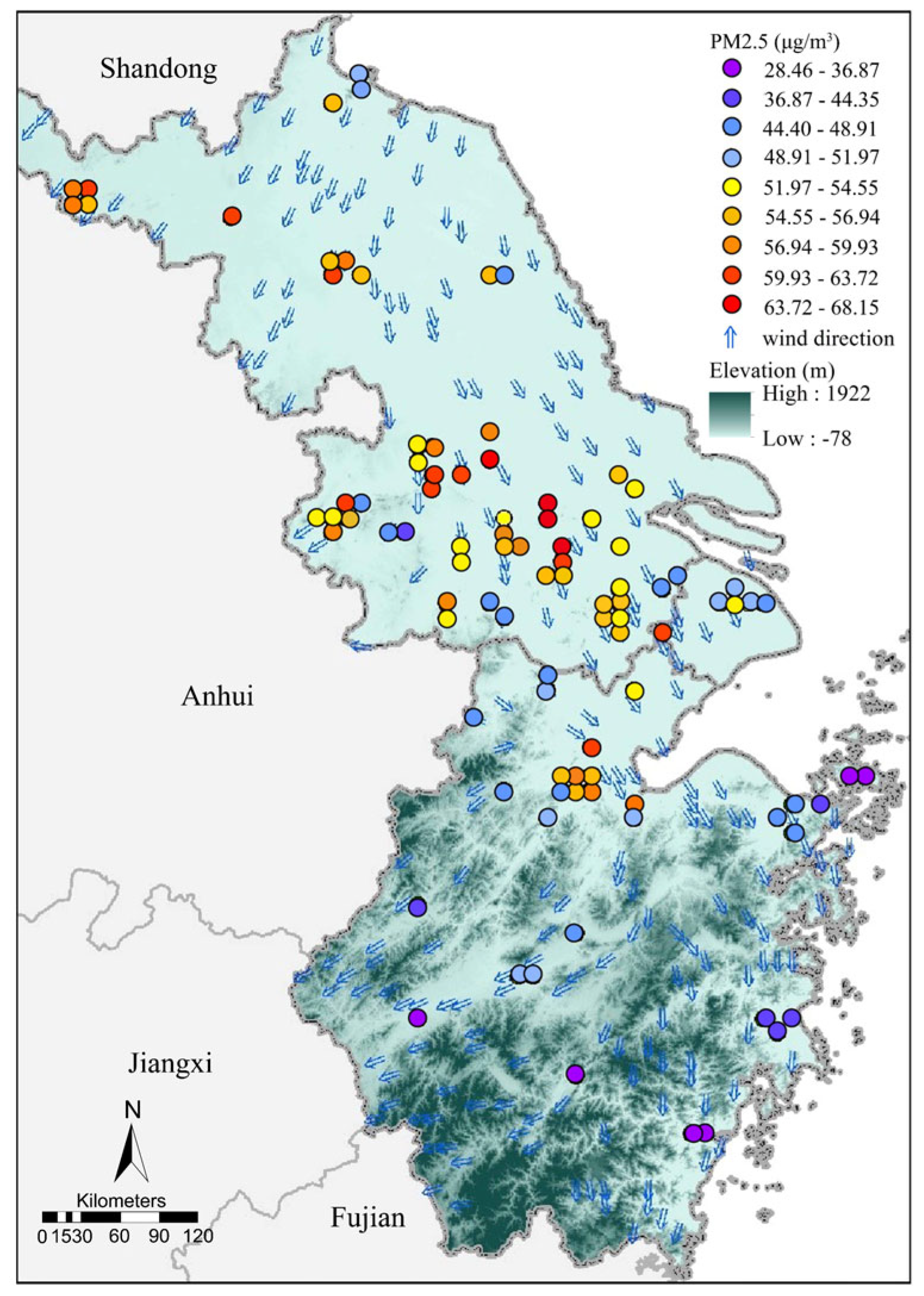

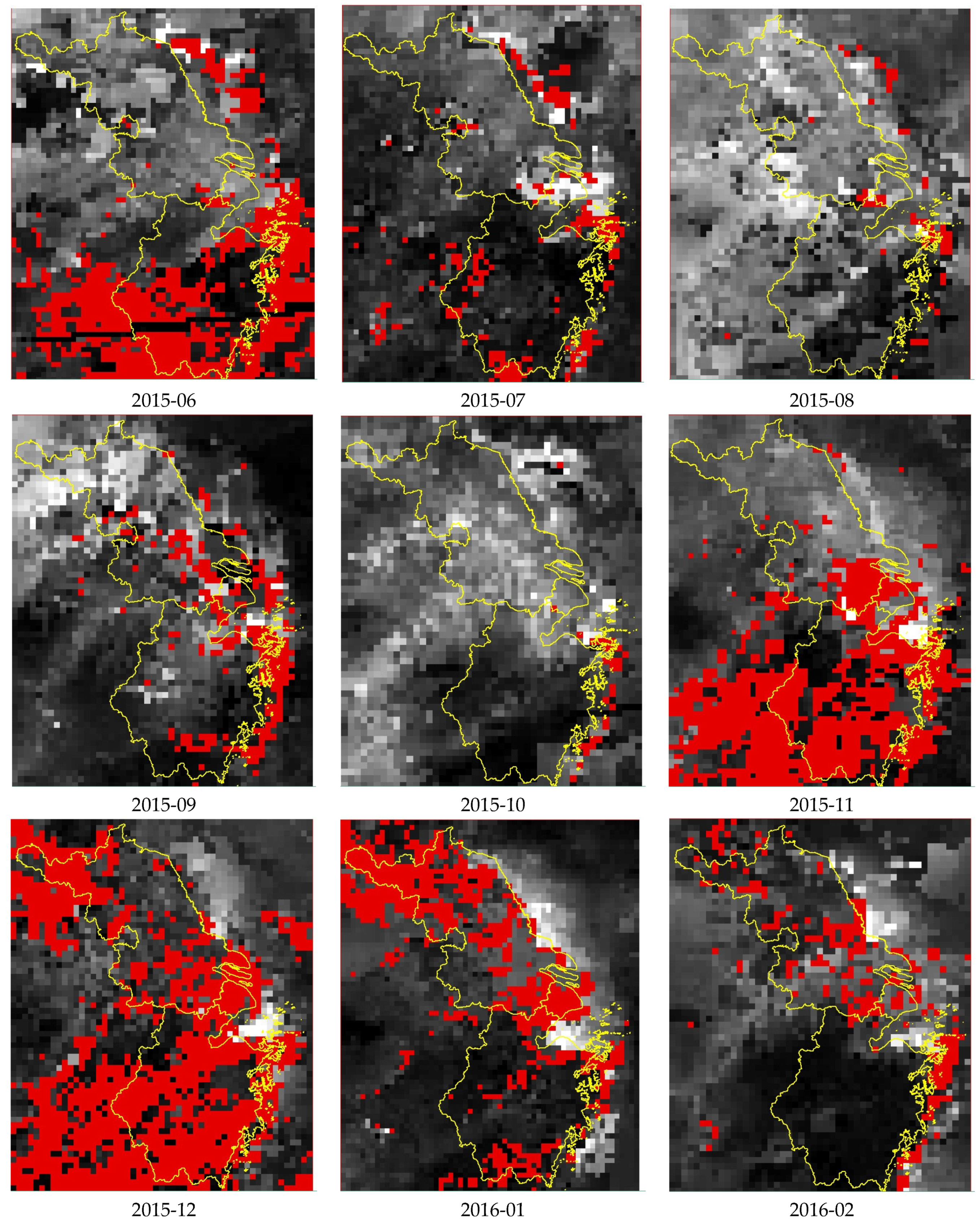

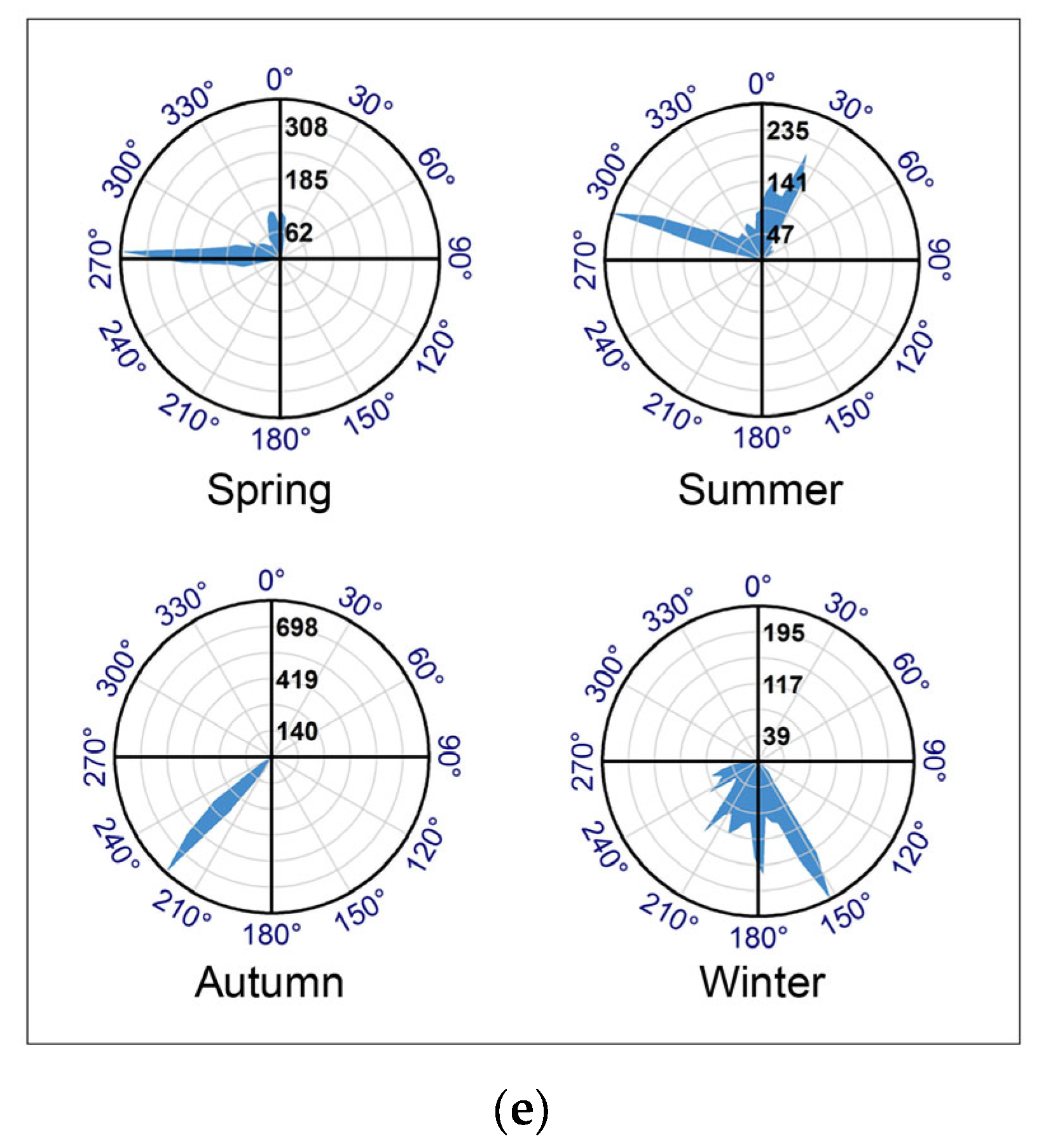

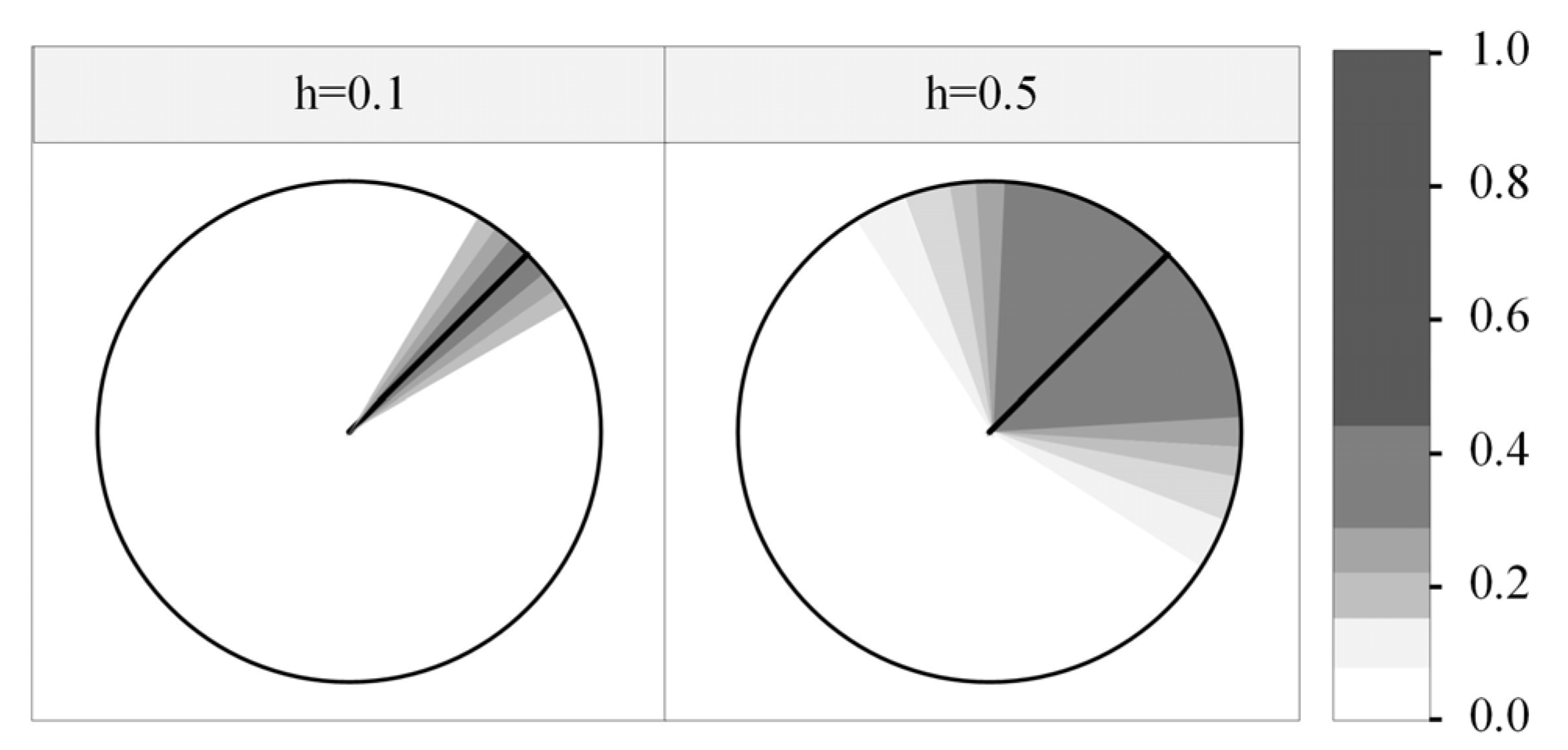
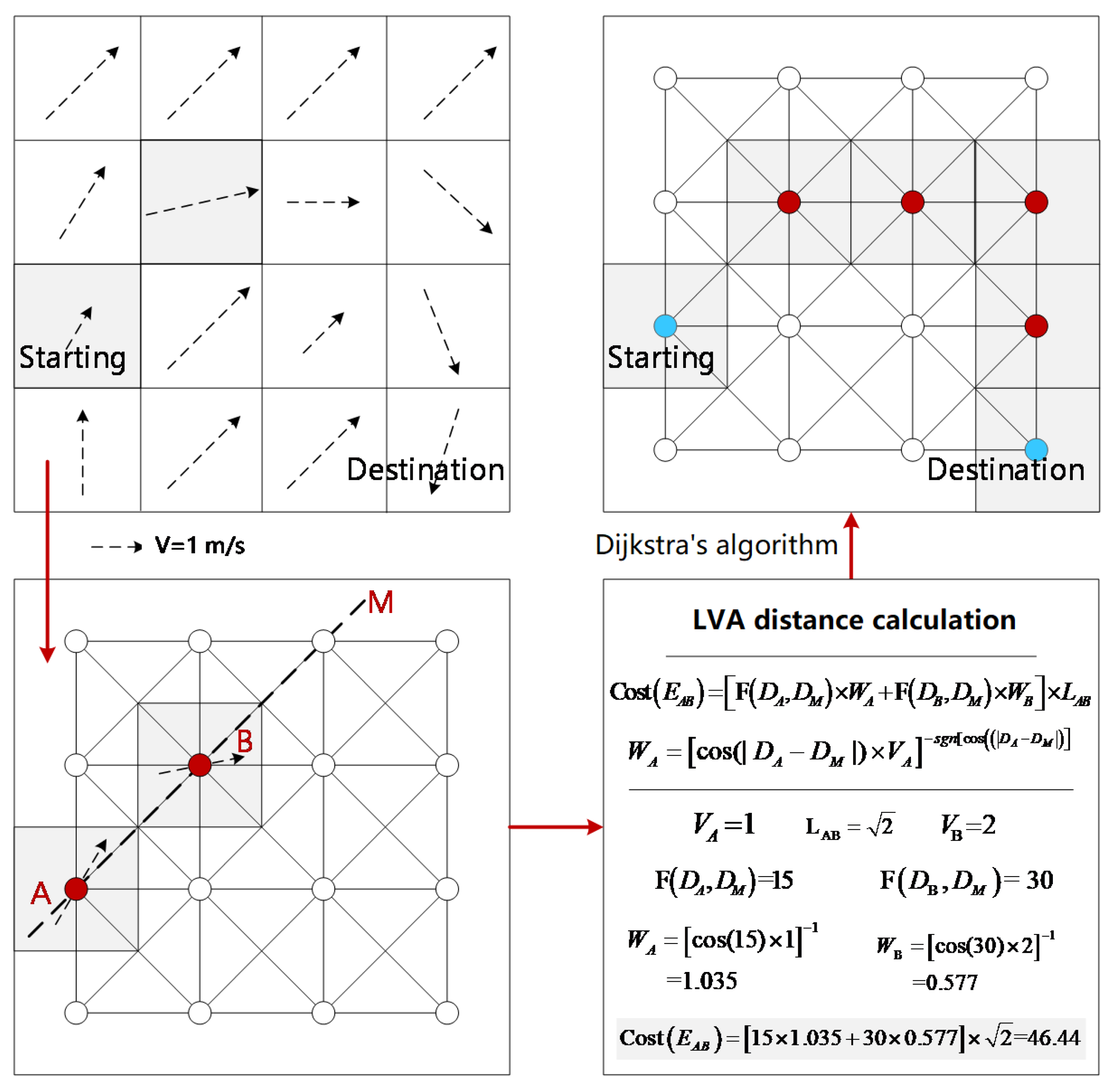

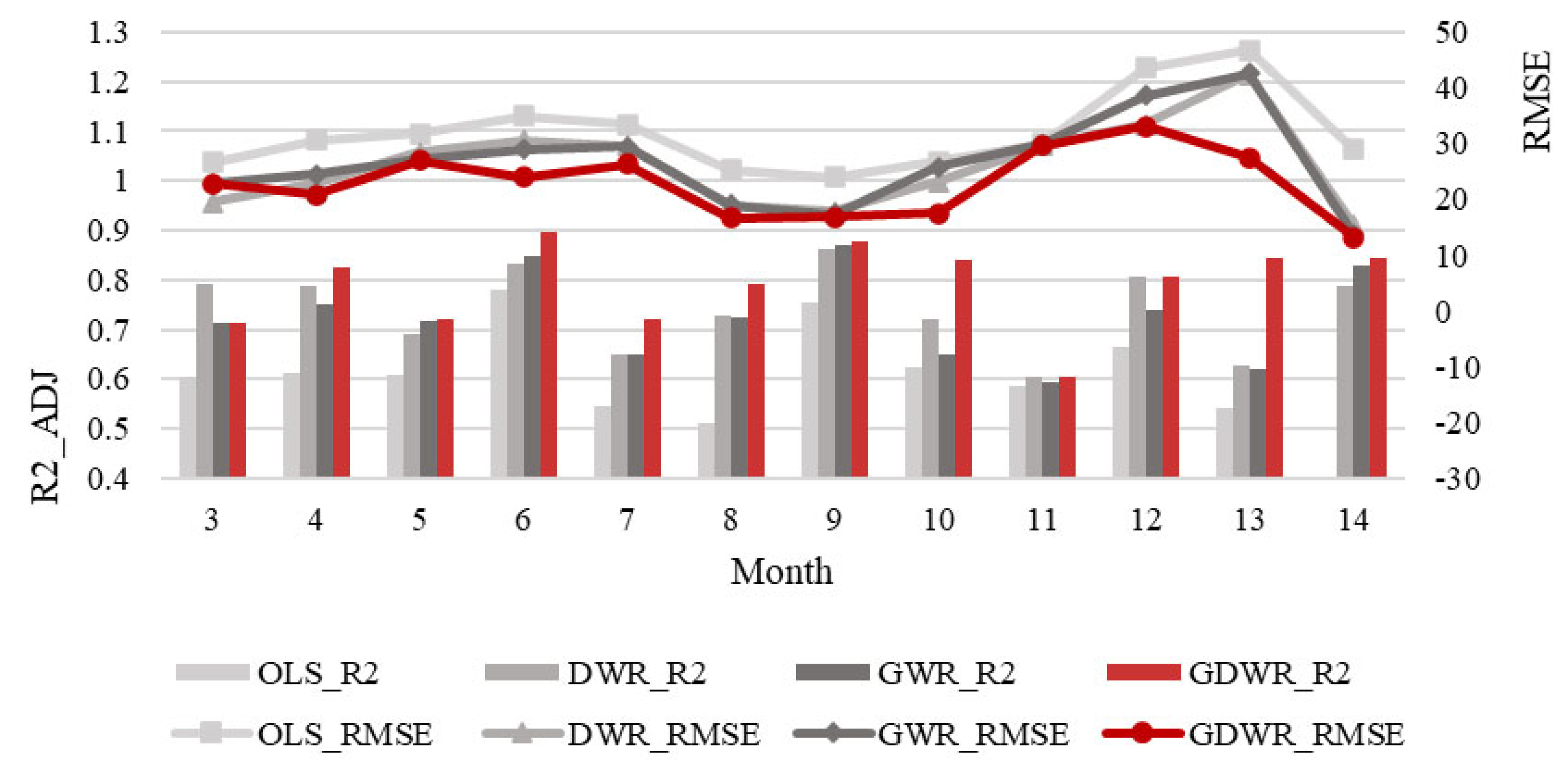
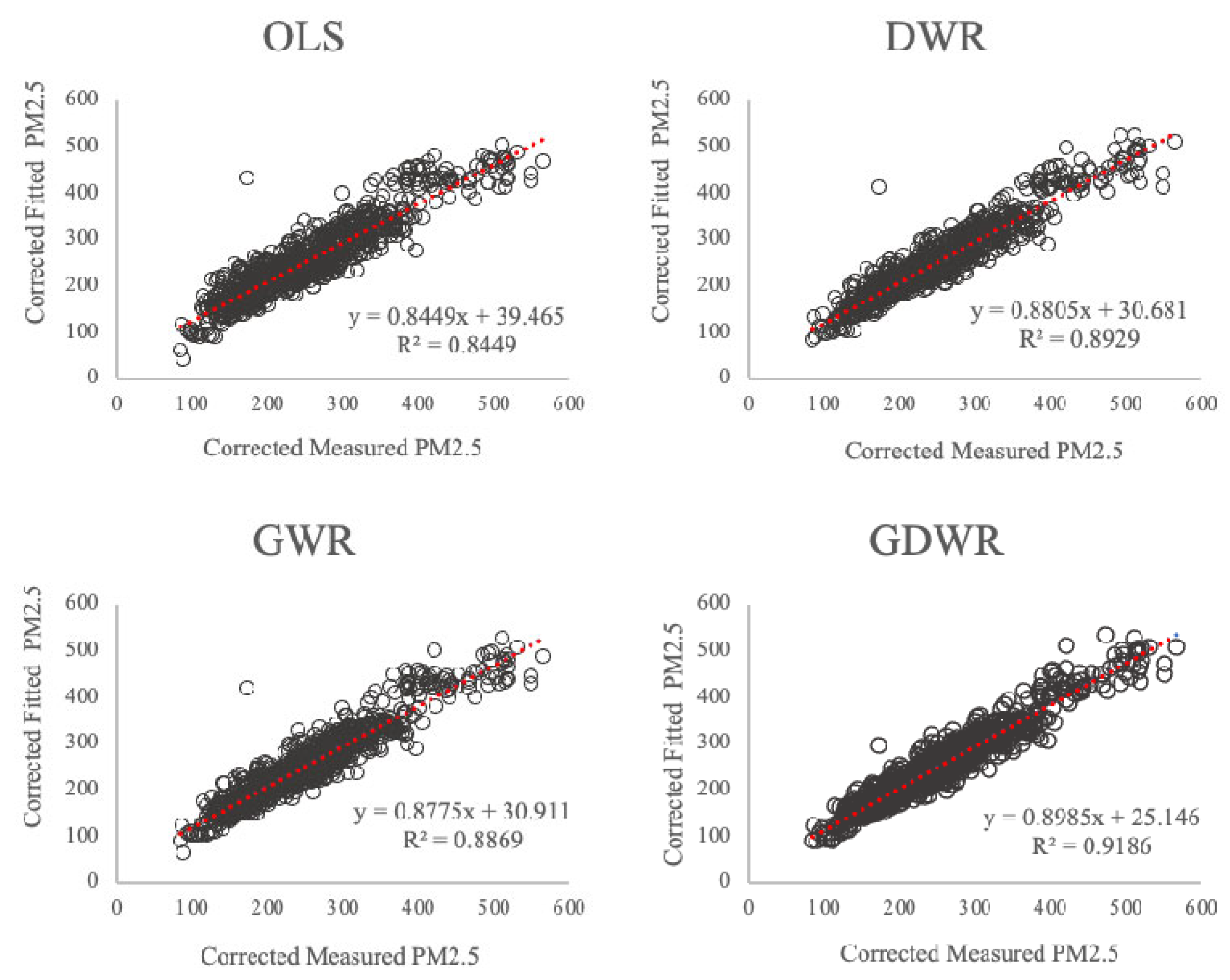
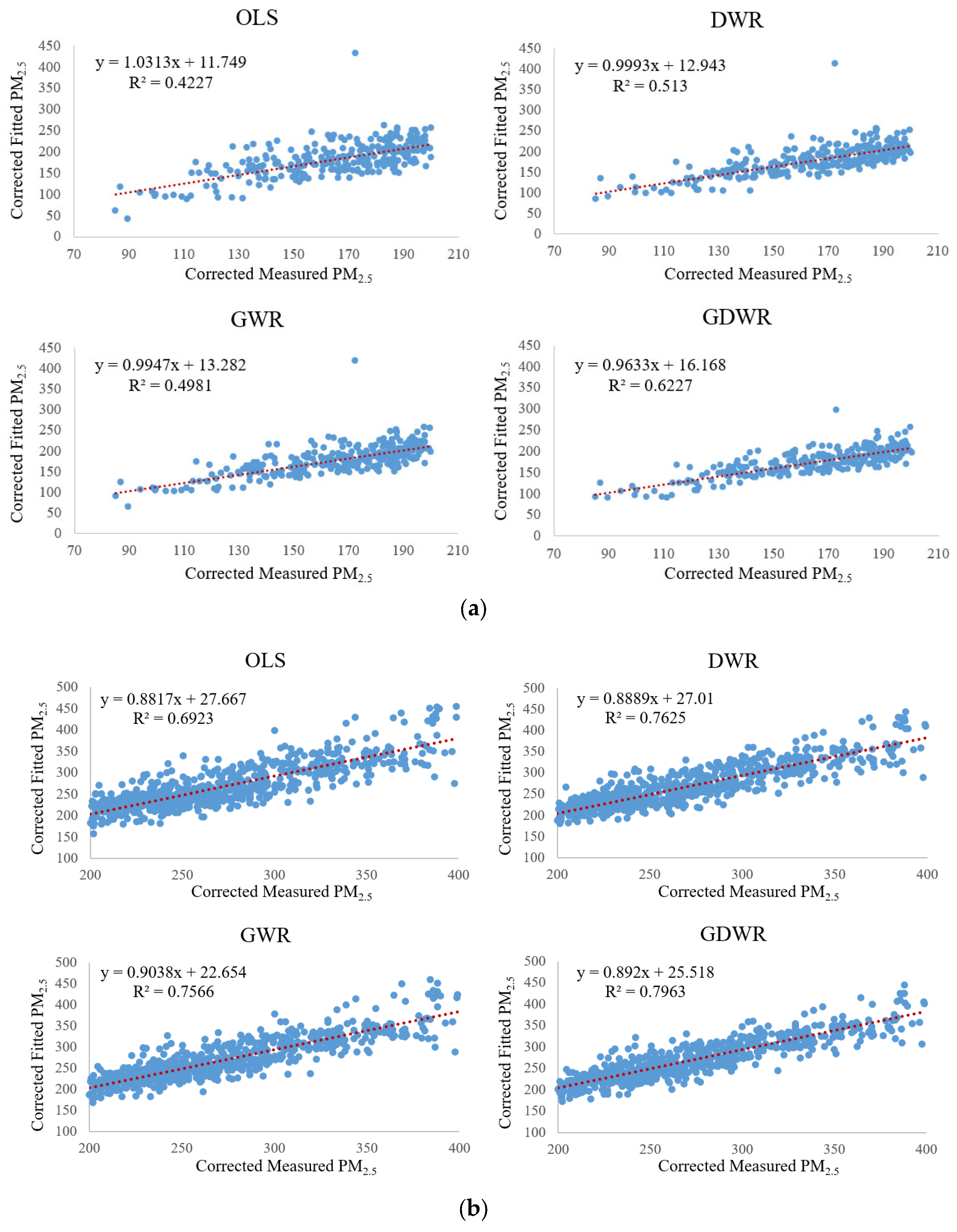
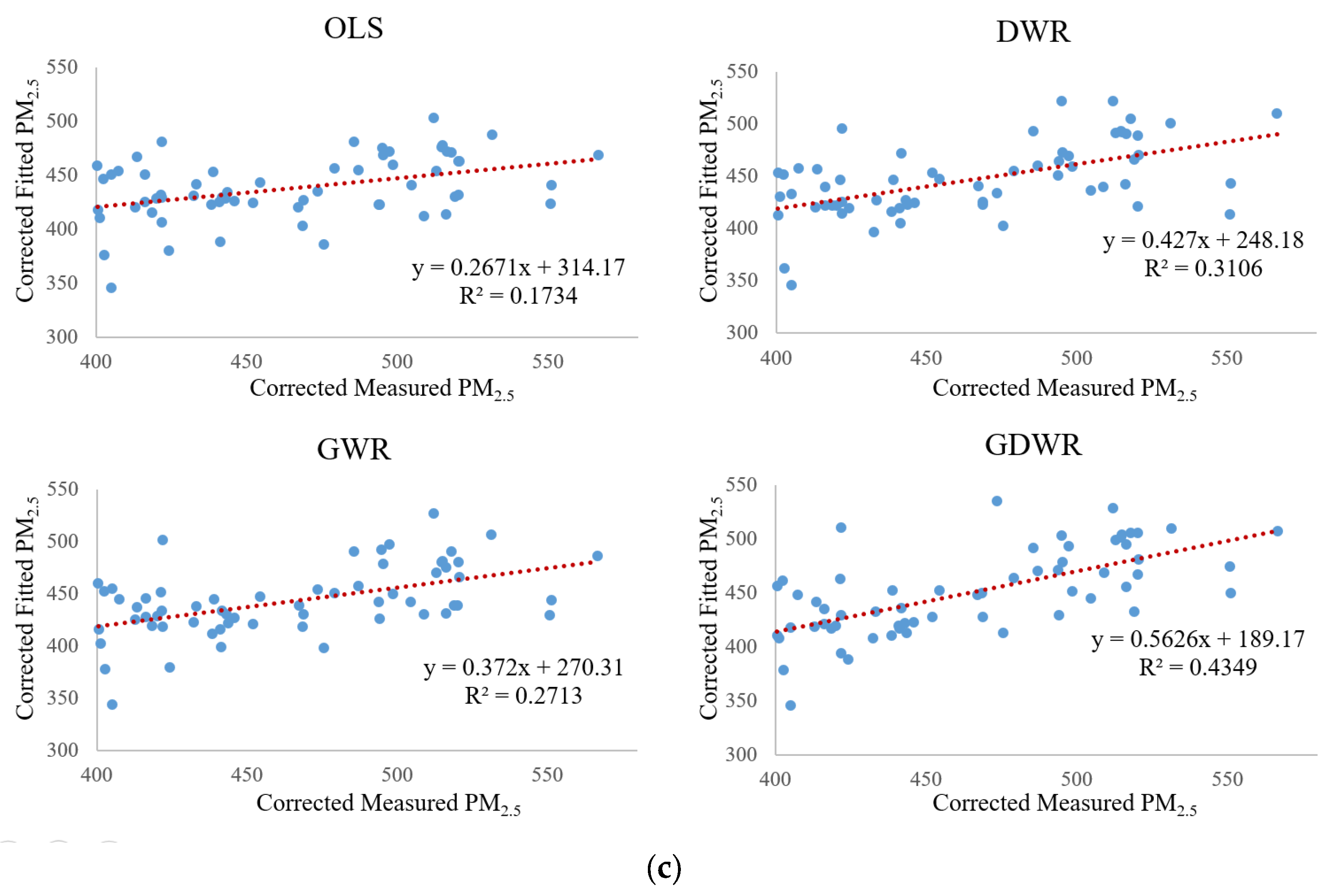

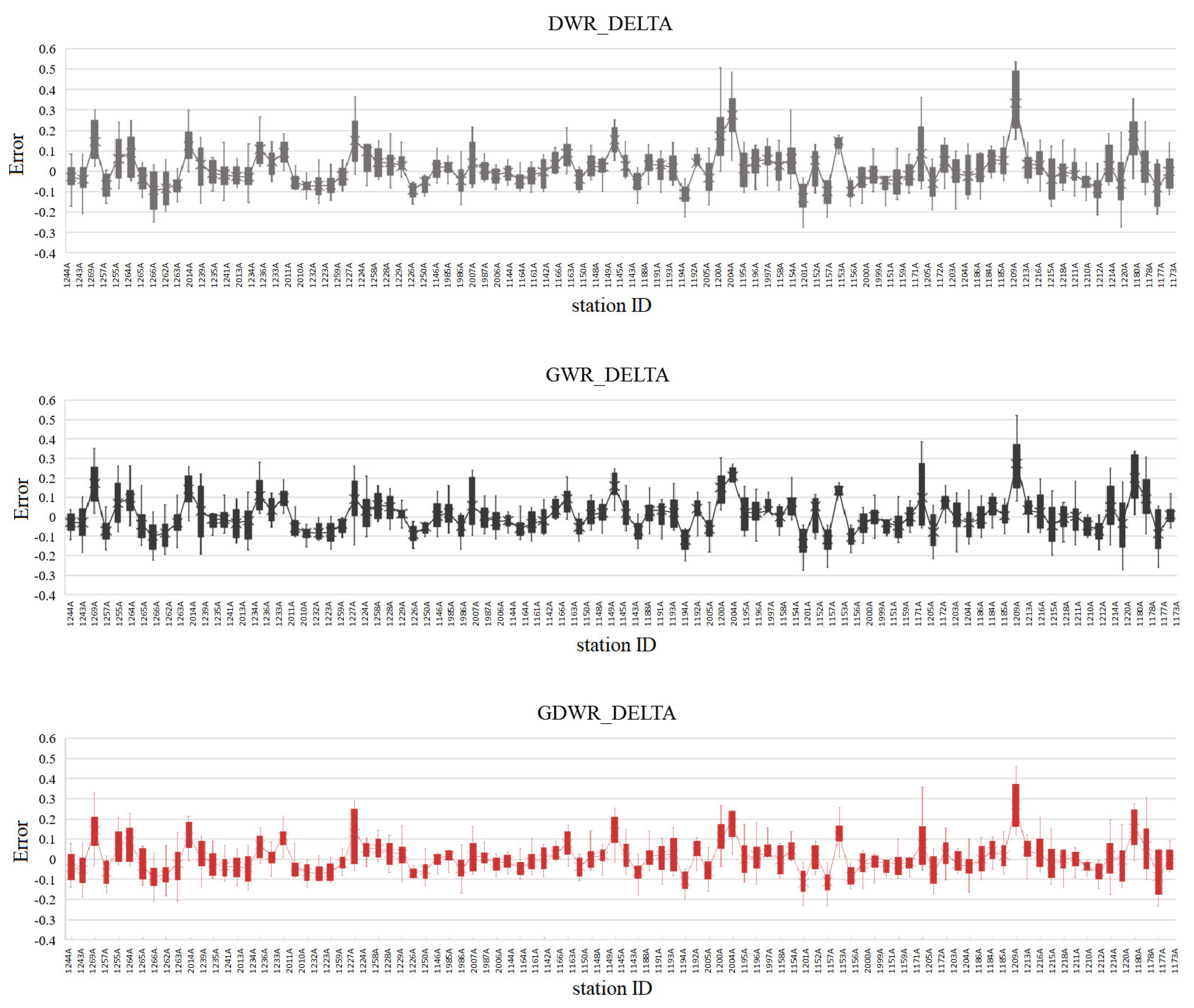
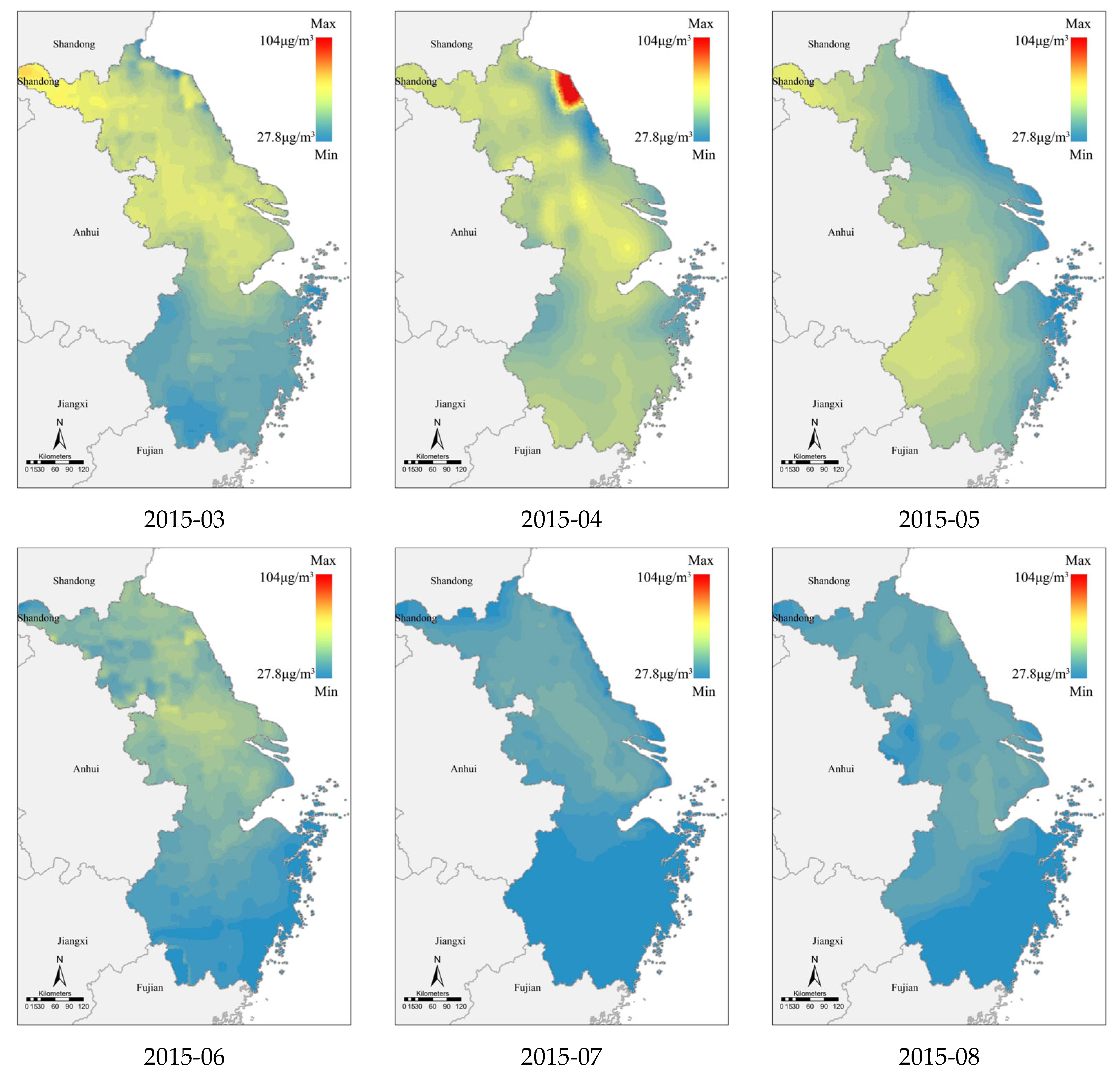
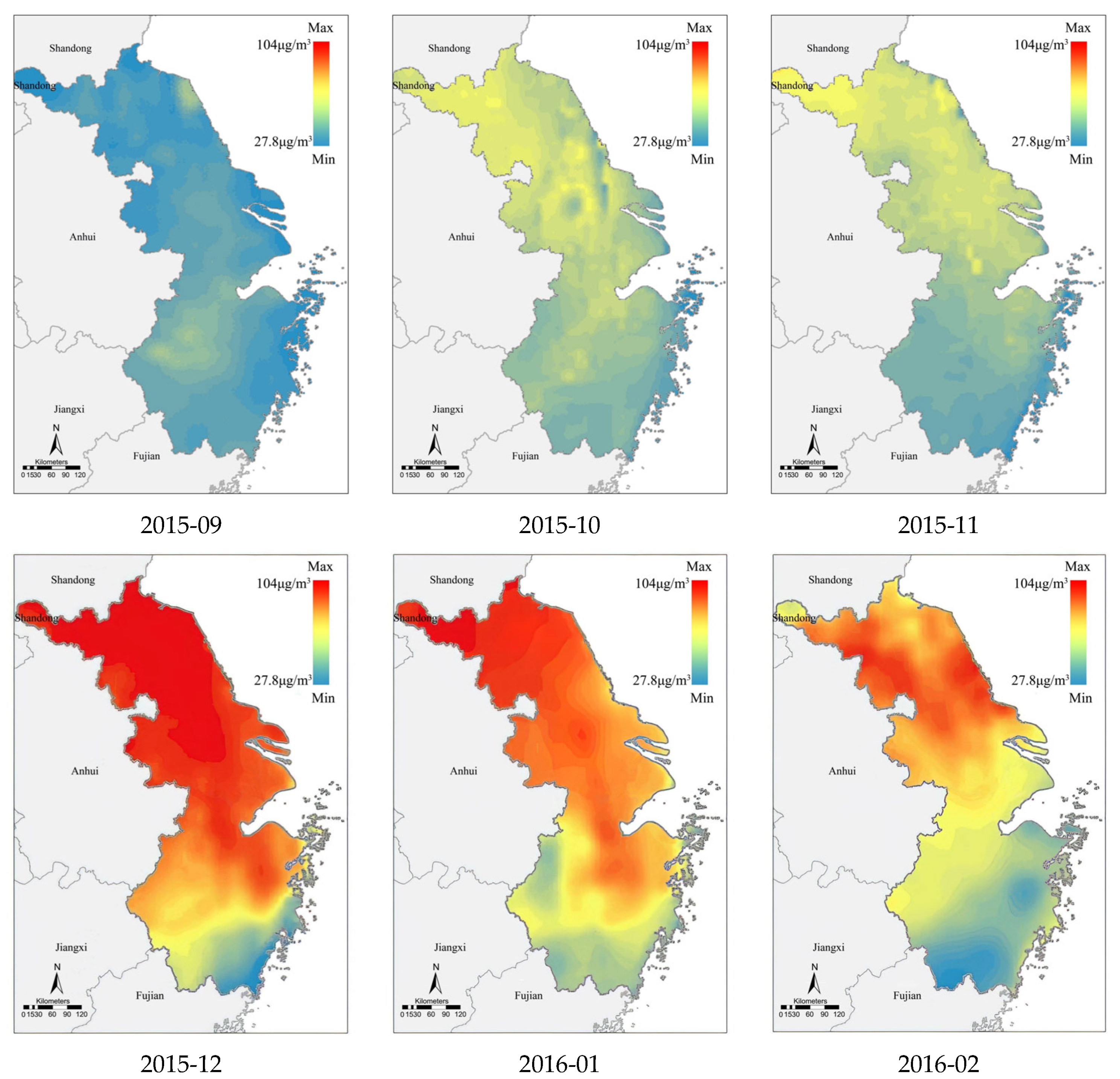
| Month | DWR | GWR | GDWR |
|---|---|---|---|
| 3 | 2.220 | 2.466 | 2.898 |
| 4 | 2.143 | 3.942 | 2.306 |
| 5 | 1.628 | 2.079 | 1.921 |
| 6 | 2.264 | 3.011 | 1.687 |
| 7 | 2.133 | 2.464 | 1.995 |
| 8 | 1.791 | 2.500 | 1.891 |
| 9 | 2.438 | 2.759 | 3.094 |
| 10 | 1.574 | 2.331 | 1.755 |
| 11 | 1.005 | 1.897 | 1.261 |
| 12 | 2.411 | 2.773 | 1.941 |
| 13 | 1.884 | 2.690 | 2.016 |
| 14 | 2.556 | 2.745 | 2.211 |
Publisher’s Note: MDPI stays neutral with regard to jurisdictional claims in published maps and institutional affiliations. |
© 2021 by the authors. Licensee MDPI, Basel, Switzerland. This article is an open access article distributed under the terms and conditions of the Creative Commons Attribution (CC BY) license (https://creativecommons.org/licenses/by/4.0/).
Share and Cite
Xuan, W.; Zhang, F.; Zhou, H.; Du, Z.; Liu, R. Improving Geographically Weighted Regression Considering Directional Nonstationary for Ground-Level PM2.5 Estimation. ISPRS Int. J. Geo-Inf. 2021, 10, 413. https://doi.org/10.3390/ijgi10060413
Xuan W, Zhang F, Zhou H, Du Z, Liu R. Improving Geographically Weighted Regression Considering Directional Nonstationary for Ground-Level PM2.5 Estimation. ISPRS International Journal of Geo-Information. 2021; 10(6):413. https://doi.org/10.3390/ijgi10060413
Chicago/Turabian StyleXuan, Weihao, Feng Zhang, Hongye Zhou, Zhenhong Du, and Renyi Liu. 2021. "Improving Geographically Weighted Regression Considering Directional Nonstationary for Ground-Level PM2.5 Estimation" ISPRS International Journal of Geo-Information 10, no. 6: 413. https://doi.org/10.3390/ijgi10060413
APA StyleXuan, W., Zhang, F., Zhou, H., Du, Z., & Liu, R. (2021). Improving Geographically Weighted Regression Considering Directional Nonstationary for Ground-Level PM2.5 Estimation. ISPRS International Journal of Geo-Information, 10(6), 413. https://doi.org/10.3390/ijgi10060413






